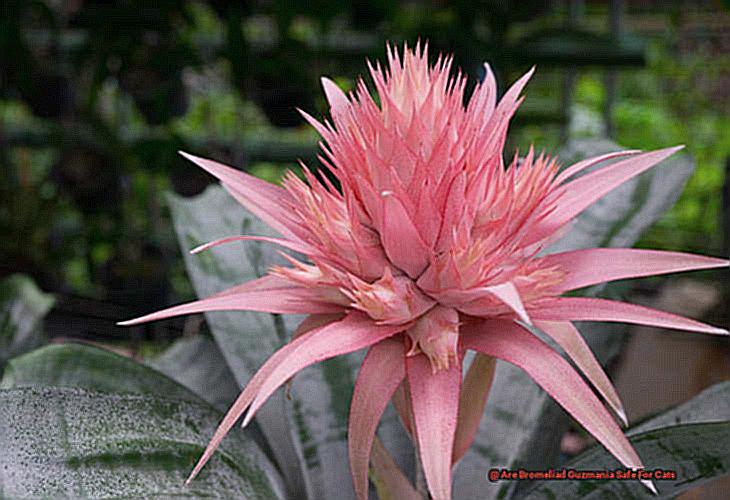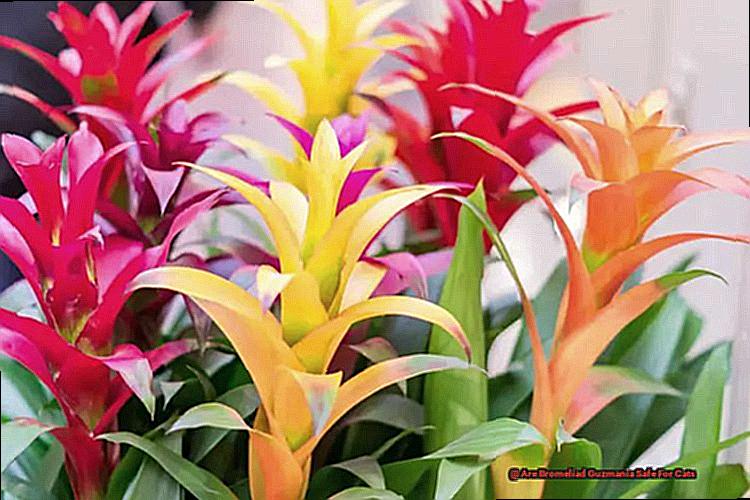Let’s talk about a hot topic in the world of houseplants – bromeliad guzmania. These beauties have been popping up all over Instagram with their vibrant colors and unique shape.
But as cat owners, we can’t help but wonder: is it safe for our furry friends? Well, I’ve done the research for you and in this blog post, I’ll spill all the tea on the safety of bromeliad guzmania for cats.
So, grab your cup of coffee (or catnip tea) and let’s dig into this together.
Are Bromeliad Guzmania Safe For Cats?
Contents
You’ve probably seen the stunning bromeliad guzmania plant in your local nursery or even in a friend’s home. Its vibrant, colorful flowers and low maintenance care make it a popular choice among houseplant enthusiasts. But as a cat owner, you may be wondering – is this plant safe for my feline companion? In this blog post, we’ll explore the potential risks and precautions to consider when bringing a bromeliad guzmania into your cat-friendly home.
Understanding Toxicity Levels in Plants for Cats:
As cat owners, we know how curious our furry friends can be. They love to explore their surroundings and may even chew on plants out of curiosity. That’s why it’s essential to know which plants are safe for cats and which ones can be toxic. The toxicity levels of plants can vary, with some being mildly irritating and others being deadly. For example, lilies and philodendron are highly toxic to cats, while others like bromeliad guzmania fall under the “safe” category.
Expert Opinion:
According to the ASPCA (American Society for the Prevention of Cruelty to Animals), bromeliad plants, including guzmania, are non-toxic to cats. This means that if your cat ingests parts of this plant, such as leaves or flowers, it is not expected to cause severe illness or death. However, this does not mean that there are no potential risks involved.
Potential Risks and Precautions:

While bromeliads are considered safe for cats, it’s still crucial to take precautions and monitor your cat around these plants. Some cats may still experience mild gastrointestinal upset if they ingest parts of the plant. Additionally, the use of fertilizers or pesticides on these plants can be toxic to cats if ingested. Therefore, it’s best to use pet-safe products or avoid using them altogether.
Another potential risk is the sharp leaves of bromeliad guzmania, which can cause injury to curious cats who like to investigate plants by swatting and chewing on them. To prevent any accidents, it’s best to keep these plants out of reach of your feline friend or choose varieties with softer leaves.
The Curiosity of Cats and Their Tendency to Chew on Plants
Cats are fascinating creatures with a natural instinct to explore their surroundings. From sniffing and touching to climbing and jumping, they are always on the lookout for new adventures. However, one of their curious behaviors that can cause concern for cat owners is their tendency to chew on plants.
As experts on feline behavior, we understand the curiosity of cats and their need to explore. In this section, we will delve deeper into why cats chew on plants and address the potential dangers of certain plants, such as the Bromeliad guzmania, for our feline friends. We have also included a list of safe and toxic plants for cats to help you keep your furry companion out of harm’s way.
Why Do Cats Chew on Plants?
It is no secret that cats are carnivores and require meat in their diet. However, they also have a natural need for fiber, which they often satisfy by chewing on plants. This behavior is most commonly seen in kittens as they learn about their environment, but it can also be seen in adult cats.
Cats are curious creatures and use their sense of taste to explore their surroundings. Chewing on plants allows them to experience new textures and flavors while also providing them with some of the necessary nutrients they need. This behavior is not necessarily harmful, but it can become a problem when cats chew on toxic plants.
The Dangers of Certain Plants for Cats
While some plants may be safe for cats to chew on, others can be toxic and even fatal. One such plant is the Bromeliad guzmania, a popular houseplant known for its beautiful flowers that can catch a cat’s attention. According to the ASPCA, this plant is considered toxic to cats and can cause vomiting, diarrhea, and drooling if ingested.
As cat owners, it is our responsibility to ensure the safety of our furry companions. We must be aware of the plants in our homes and yards that can potentially harm our cats. This includes not only toxic plants but also those with sharp edges or thorns that can injure them.
Tips for Keeping Cats Safe Around Plants
Thankfully, there are ways to keep our curious felines safe around plants. Here are some tips to consider:
Know Your Plants: Familiarize yourself with the plants in your home and yard to identify any potential dangers for your cat.
Understanding Toxicity Levels in Plants for Cats
As a cat owner, you know how curious and mischievous our feline friends can be. They love to explore their surroundings and, unfortunately, this includes nibbling on plants. While some plants may just cause a mild tummy ache, others can be harmful and even fatal to cats. This is why it is crucial to understand the toxicity levels of plants, such as the popular houseplant Bromeliad guzmania, when it comes to our furry companions.
So, what makes Bromeliad guzmania potentially dangerous for cats? Let’s dive into the research.
According to the ASPCA, Bromeliad guzmania is considered to be mildly toxic to cats. This means that if your cat ingests this plant, it may experience some gastrointestinal discomfort like vomiting or diarrhea. The leaves of the plant contain insoluble calcium oxalate crystals that can irritate your cat’s mouth and throat if consumed. While this may not sound too serious, it is still important to keep this plant out of reach of your cat as ingestion of large amounts can lead to more severe symptoms such as difficulty breathing and weakness.
But why are certain plants toxic to cats while others are not? It all comes down to the compounds found in plants. In the case of Bromeliad guzmania, the insoluble calcium oxalate crystals are the main cause of concern for cats. These crystals can also be found in other popular houseplants like peace lilies and philodendrons, so it is important to do your research before bringing any new plants into your home.
It’s also worth noting that certain factors can affect the toxicity levels of plants for cats. These include the age and size of your cat, as well as any underlying health conditions they may have. Therefore, it is always best to err on the side of caution and avoid exposing cats to potentially harmful plants.
So, what are the common signs of plant toxicity in cats? Keep an eye out for drooling, swelling of the mouth or tongue, difficulty swallowing, and excessive licking or pawing at the mouth. If your cat displays any of these symptoms after being exposed to Bromeliad guzmania, it is important to seek immediate veterinary care.
Why Bromeliad Guzmania is Considered Safe for Cats
If you’re a cat owner, you know how curious and playful our furry friends can be. They love exploring their environment, and sometimes that includes chewing on plants. As a responsible pet owner, it’s important to make sure that the plants in your home are safe for your feline companion. One popular houseplant that many cat owners wonder about is the bromeliad guzmania. In this post, we’ll dive into why this plant is considered safe for cats and how it can even benefit their health.
Non-Toxic and Harmless
First and foremost, it’s important to note that bromeliad guzmania is listed as non-toxic to cats by the ASPCA (American Society for the Prevention of Cruelty to Animals). This means that the plant is not poisonous to cats if ingested. The reason for this is that bromeliad plants do not contain any toxic substances that can harm cats. So, you can breathe a sigh of relief knowing that this popular houseplant won’t cause any harm to your beloved pet.
No Harmful Substances
As mentioned earlier, bromeliad guzmania does not contain any harmful substances that can harm cats. Other plants may have toxic components such as insoluble calcium oxalate crystals, which can cause gastrointestinal discomfort and other serious symptoms if ingested. However, this is not the case with bromeliads. These plants are completely safe for your cat to be around.
Possible Allergic Reactions
While bromeliad guzmania is generally considered safe for cats, it’s always important to monitor your pet’s behavior around new plants. Some cats may have allergic reactions to certain plants, just like humans. If your cat shows any signs of allergies such as sneezing, watery eyes, or skin irritation when around bromeliad guzmania, it’s best to keep them away from the plant. It’s always better to be safe than sorry when it comes to your cat’s health.
Potential Benefits for Cats
Other Common Household Plants That Can Be Harmful to Cats
As cat owners, we all know the importance of keeping our furry friends safe from harm. That’s why we make sure to keep toxic plants like lilies and philodendrons out of reach. But did you know that there are other common household plants that can also pose a threat to cats? One such plant is the bromeliad guzmania, a tropical plant known for its vibrant colors and unique appearance.
While it may not be as well-known as other toxic plants, it’s still important for cat owners to be aware of its potential dangers. So, let’s take a closer look at why caution should be taken when bringing this plant into a home with cats.
Toxicity Concerns
Like many other plants, bromeliad guzmania contains toxins that can be harmful to cats if ingested. These toxins can cause vomiting, diarrhea, and even more serious symptoms such as difficulty breathing or organ failure. While the risk may be low if your cat only takes a small nibble, it’s always better to err on the side of caution.
Non-Toxic Nature?
You may have come across information stating that bromeliad guzmania is non-toxic to cats. While this is true in comparison to other toxic plants, it’s important to note that the plant still contains substances that can cause harm if consumed in large quantities. Plus, not all cats react the same way to toxins, so it’s best to avoid any potential risks altogether.
Potential Benefits for Cats?
Some sources claim that bromeliad guzmania can have benefits for cats, such as improving their respiratory health and reducing stress and anxiety. While there may be some truth to these claims, there is no scientific evidence to support them. It’s always best to stick to proven methods for improving your cat’s health and wellness.
What Should You Do?
If you already have a bromeliad guzmania in your home, don’t panic. The risk of toxicity may be low, but it’s still essential to take precautions. Here are some steps you can take to keep your cat safe:
Monitoring Your Cat Around Houseplants, Including Bromeliad Guzmania
While this tropical plant may seem harmless with its vibrant colors and unique appearance, it can still pose a threat to our feline companions. As an expert on the topic, I cannot stress enough the importance of monitoring your cat’s behavior around houseplants, especially bromeliads.
First and foremost, let’s address the fact that bromeliad guzmania plants are not toxic to cats. However, they can still cause some discomfort if ingested. This is why it is crucial to keep a close eye on your cat’s interactions with these plants. Cats are curious creatures, and they may be tempted to chew on or play with houseplants, including bromeliads. This can lead to stomach upset or mild irritation of the mouth and throat.
But what exactly should you be looking out for when it comes to monitoring your cat around bromeliads? The most common symptoms of ingestion include drooling, vomiting, and diarrhea. In rare cases, more serious reactions such as difficulty breathing or an allergic reaction may occur.
To prevent your cat from accessing the plant, consider placing it in a high location or using a barrier such as a plant stand or hanging basket. It is also important to regularly check the plant for any signs of damage or wilting, as this could indicate that your cat has been interacting with it.
In case of any ingestion or contact with the plant, it is crucial to seek immediate veterinary advice. Another option is to only have bromeliad guzmania plants in rooms that are off-limits to your cat, such as a closed-off office or bedroom.
But don’t worry, you can still enjoy the beauty of these unique plants in your home. Just remember to always supervise your cat when they are around plants and remove any fallen leaves or petals from the area to prevent accidental ingestion.
If you have multiple cats, it is important to monitor their interactions with the plant as well. Some cats may be more curious and likely to interact with plants, while others may not be interested at all. By taking these precautions, you can ensure your cat’s safety and enjoy the beauty of bromeliad guzmania plants in your home.
Potential Dangers of Bromeliad Guzmania for Cats
There are certain dangers lurking in our homes that we may not even be aware of. One such danger is the bromeliad guzmania plant. While this plant may add a pop of color to your home decor, it can also pose serious risks to your furry friends. As an expert on the topic, let me guide you through the potential dangers of bromeliad guzmania for cats.
Toxicity:
First and foremost, bromeliad guzmania plants contain toxins that can be harmful to our feline friends if ingested. These toxins come in the form of saponins and calcium oxalate crystals, which can cause irritation and inflammation in the mouth, throat, and digestive tract. So if you notice your cat playing with or chewing on this plant, it’s important to intervene immediately.
Bright colors:
Cats are naturally curious creatures and may be drawn to the bright colors of bromeliad guzmania plants. This can lead them to sniff, play with, or even ingest the plant, putting them at risk for toxicity. So as much as we love how these plants add a touch of vibrancy to our homes, we must also be cautious about their potential danger to our furry friends.
Allergic reactions:
Aside from toxicity, some cats may also have allergic reactions to bromeliad guzmania plants. This can manifest as skin irritation or respiratory issues if they come into contact with the plant or inhale its pollen. So if you notice any unusual symptoms in your cat after being around this plant, it’s best to consult with your veterinarian.
Gastrointestinal issues:
If your cat does happen to ingest part of a bromeliad guzmania plant, they may experience gastrointestinal issues such as vomiting, diarrhea, or difficulty swallowing. These symptoms can be uncomfortable for your cat and may require medical attention if they persist.
Choking hazard:
The long and narrow leaves of bromeliad guzmania plants can pose a choking hazard for cats if they try to ingest them. This is especially concerning for kittens or older cats who may have weaker immune systems and are more vulnerable to choking.
Conclusion
To sum it up, bromeliad guzmania plants may seem like a harmless addition to our homes, but they can actually pose a threat to our cats. As responsible pet owners, it is crucial for us to educate ourselves on the safety of houseplants for cats and take necessary precautions.
Despite being considered non-toxic, these plants still contain substances that can cause discomfort if ingested by our feline friends. It’s essential to closely monitor their behavior around these plants and seek immediate veterinary care if any signs of ingestion or allergic reactions are noticed.
Moreover, it’s important to be aware of the toxicity levels of other common household plants as well. By understanding which plants are safe and which ones are harmful, we can create a safe environment for our cats to thrive in.
Ultimately, finding a balance between having a beautiful home with houseplants and ensuring the safety of our pets is key. With proper research and precautions, we can enjoy the beauty of bromeliad guzmania plants without putting our furry companions at risk.






